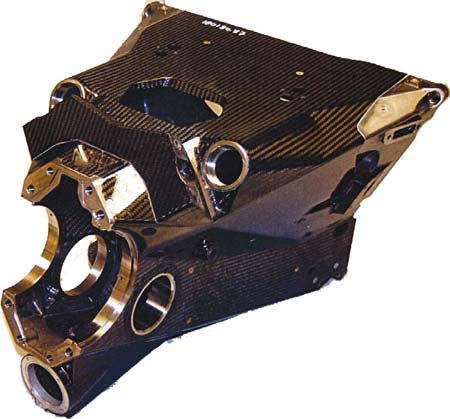Composites
Motorsport engineers are constantly striving to create ever-lighter and more efficient components, yet at the same time they must stay within regulatory frameworks and ensure the components are durable under race conditions. Last month we touched on the subject of using composites for the construction of transmission casings, a subject we will look at in more depth here.
Composites have been used to great effect in racecar construction since the 1980s, but it is only in the past decade that materials technology and understanding of composites have made their use in transmissions possible. When first introduced, most carbon fibre parts were constructed using the 'wet lay-up' process, where dry carbon fibre weave is coated with an epoxy resin, in essentially the same manner as glass-reinforced plastic had been constructed.
The advent of pre-preg materials, where the carbon weave is pre-impregnated with thermo-curing resin, and the use of autoclaves, dramatically increased what was possible with composites. Unsurprisingly, Formula One was the first place composite gearboxes appeared, and with the exception of Audi's R18 e-tron quattro and ultra sportscars, this remains their sole preserve. The main reasoning behind this is cost, in terms of development, production and durability.
The biggest challenge in creating a composite gearbox casing is ensuring that it has the correct structural properties while still allowing for the compact packaging of the internals. Carbon structures can be made very substantial, but until recently, FEA simulation of laminate structures was not as advanced as for metallic structures, so engineers had to work very much on knowledge gained through prior experience. Modern FEA packages, however, are capable of accurately modelling the properties of composites, allowing structures that require strength and stiffness in multiple planes (such as a gearbox) to be analysed.
If resources are sufficient then the performance gains that a composite casing affords make their adoption viable. Honda's 2006 RA106 Formula One car featured a composite transmission casing, which the team said was 30% lighter with 14% greater torsional stiffness than a similar aluminium unit. A titanium casing would come close to these gains, but the cost implications of producing one are just as onerous as a composite unit.
The RA106's casing was made from a monolithic, uncored laminate that varied in thickness from 2 to 4 mm (0.08-0.16 in). The casing also featured two internal 'bulkheads' consisting of composites with titanium inserts, which supported the rotating assemblies. Similar to the rest of the car's monocoque, the external mounting points for suspension assemblies were made from titanium, and chemically treated to improve bonding to the carbon structure.
Beyond the obvious loading that a gearbox is subjected to, thanks to powertrain and cornering forces, the environment it lives in is a hostile one, especially in a single seater. The biggest enemy is heat - both the engine and exhaust systems are in very close proximity, and the ambient temperature in this area is likely be considerably higher than regular composites can tolerate.
Advances in the epoxy resins used in the laminating process have therefore been key to making composite gearboxes a viable proposition. Most epoxy resins begin to fail above 150 C, but new high-temperature epoxy resins have become available that are stable to over 300 C which, combined with technologies such as heat-resistant coatings, allow composites to survive in areas where previously this was not possible.
These days, composite casings are still far from commonplace. The front-running teams in the Formula One paddock all run them, but it is still likely to be some time before they can be found on racers in the lower series.

Fig. 1 - Honda's 2006 RA106 featured a composite gearbox casing (Courtesy of Honda Racing)
Written by Lawrence Butcher